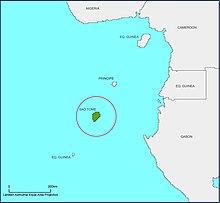São Tomé grosbeak
| São Tomé grosbeak | |
|---|---|
| Scientific classification | |
| Domain: | Eukaryota |
| Kingdom: | Animalia |
| Phylum: | Chordata |
| Class: | Aves |
| Order: | Passeriformes |
| Family: | Fringillidae |
| Subfamily: | Carduelinae |
| Genus: | Crithagra |
| Species: | C. concolor
|
| Binomial name | |
| Crithagra concolor (Barboza du Bocage, 1888)
| |

| |
| range | |
| Synonyms | |
| |
The São Tomé grosbeak (Crithagra concolor) is the largest member of the canary genus Crithagra,[2] 50% heavier than the next largest canary species,[3] and possesses a massive bill for a member of that genus. It is endemic to the island of São Tomé.[1]
For a long period this bird was known only from three nineteenth-century specimens. It was rediscovered in 1991. The current population is estimated at less than 250, and it is classified as critically endangered by the IUCN.[1] The main threat is habitat destruction.
The São Tomé grosbeak was formerly placed in the genus Neospiza (meaning "new finch"[2]) but was assigned to the genus Crithagra based on a phylogenetic analysis of mitochondrial and nuclear DNA sequences.[4][5]
Habitat
[edit]The Sao Tome Grosbeak was initially believed to inhabit only lowland native forests. Recent observations expanded its known habitat range, with sightings in secondary forests at higher elevations. This canopy-dwelling bird is quite silent and unresponsive to playback, making it challenging to detect. However, it becomes more observable during the short dry season when many birds are breeding. The Sao Tome Grosbeak often moves in pairs or alone and descends to the forest understorey to feed on seeds using its powerful bill. Understanding its habitat and behavior is crucial for its conservation on Sao Tome.[1]
Threats
[edit]Historical Deforestation and Habitat Changes
[edit]Historically, extensive lowland forest areas were cleared to establish cocoa plantations. Subsequent abandonment of these plantations led to the development of secondary forests, which are less suitable for the Sao Tome Grosbeak. Additionally, the introduction of an oil palm plantation further exacerbated habitat loss.[1]
Predators and Impact
[edit]The presence of introduced species like the Black Rat (Rattus rattus), Mona Monkey (Cercopithecus mona), African Civet (Civettictis civetta), and feral cats (Felis catus) raises concerns about potential predators of the Sao Tome Grosbeak. However, further research is needed to assess their actual impact on the bird's population.[1]
References
[edit]- ^ a b c d e f BirdLife International (2018). "Crithagra concolor". IUCN Red List of Threatened Species. 2018: e.T22720310A128249895. doi:10.2305/IUCN.UK.2018-2.RLTS.T22720310A128249895.en. Retrieved 20 November 2021.
- ^ a b Sekar, Sandhya (5 April 2017). "World's largest canary discovered on island of giants and dwarfs". New Scientist. Retrieved 6 April 2017.
- ^ Melo, M.; Stervander, M.; Hansson, B.; Jones, P. J. (2017). "The endangered São Tomé Grosbeak Neospiza concolor is the world's largest canary". Ibis. 159 (3): 673–679. doi:10.1111/ibi.12466.
- ^ Melo, Martim; Stervander, Martin; Hansson, Bengt; Jones, Peter J. (2017-07-01). "The endangered São Tomé Grosbeak Neospiza concolor is the world's largest canary". Ibis. 159 (3): 673–679. doi:10.1111/ibi.12466. ISSN 1474-919X.
- ^ Gill, Frank; Donsker, David (eds.). "Finches, euphonias". World Bird List Version 5.2. International Ornithologists' Union. Retrieved 5 June 2015.
External links
[edit]

